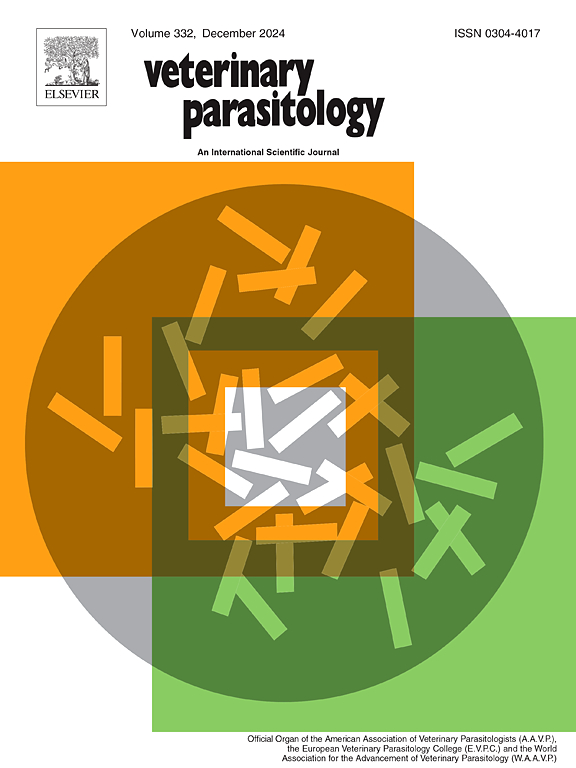骆驼鼻蝇的幼虫解剖与蛹内发育(双翅目:雌蝇科)
IF 2
2区 农林科学
Q2 PARASITOLOGY
引用次数: 0
摘要
骆驼鼻蝇幼虫(双翅目:骆驼鼻蝇科)可引起骆驼鼻咽蝇病。这种蝇蛆病可能很严重,甚至致命。在这里,使用显微计算机断层扫描和常规组织学相结合的方法,描述了第二(L2)和第三(L3)龄幼虫和蛹期内幼虫的主要器官的形态。为此,从被屠宰的骆驼的头部收集L2和L3幼虫,并将其杀死保存或允许其产卵。每隔一段时间杀灭蛹标本,制备蛹和蛹进行显微ct扫描。此外,将新鲜采集的幼虫标本固定、染色并在光镜下检查。幼虫体内结构最显著的是消化器官,约占幼虫体内体积的5. %。幼虫的唾液腺变大,相对体积与其他雌虫相似,但较短,后缘不统一成“腺带”。马氏小管的远端区域也像其他雌鸟一样扩大,但程度较轻。蛹期内幼虫的消化道逐渐缩小,反映了成虫的非摄食行为,但生殖器官高度发达,在羽化后很快就能交配。讨论了寄生蜂对寄生的形态和生理适应。本文章由计算机程序翻译,如有差异,请以英文原文为准。
Larval anatomy and intra-puparial development of the camel nasal bot fly, Cephalopina titillator (Diptera: Oestridae)
Larvae of the camel nasal bot fly, Cephalopina titillator (Diptera: Oestridae), cause nasopharyngeal myiasis in camels. This myiasis can be severe, even fatal. Here, the morphology of the main organs of second (L2) and third (L3) instar larvae and of the intra-puparial forms are described, using a combination of micro-computed tomography supported by routine histology. For this, L2 and L3 larvae were collected from the heads of slaughtered camels and were either killed and preserved or allowed to pupariate. Pupariated specimens were killed at intervals and larvae and puparia were prepared for micro-CT scanning. Additionally, freshly collected larval specimens were fixed, stained and examined by light microscopy. The most distinctive internal larval structures were the digestive organs, occupying almost 5 % of the internal larval volume. The larval salivary glands were enlarged, with a similar relative volume to other Oestrinae, but they were shorter and did not unite posteriorly in a “glandular band”. The distal region of the Malpighian tubules was also enlarged as in other Oestrinae, but to a lesser degree. The intra-puparial forms showed a gradual reduction of the digestive tract, reflecting the non-feeding behaviour of adults, yet had highly developed reproductive organs facilitating mating soon after eclosion. The morphological and physiological adaptations to parasitism are discussed.
求助全文
通过发布文献求助,成功后即可免费获取论文全文。
去求助
来源期刊

Veterinary parasitology
农林科学-寄生虫学
CiteScore
5.30
自引率
7.70%
发文量
126
审稿时长
36 days
期刊介绍:
The journal Veterinary Parasitology has an open access mirror journal,Veterinary Parasitology: X, sharing the same aims and scope, editorial team, submission system and rigorous peer review.
This journal is concerned with those aspects of helminthology, protozoology and entomology which are of interest to animal health investigators, veterinary practitioners and others with a special interest in parasitology. Papers of the highest quality dealing with all aspects of disease prevention, pathology, treatment, epidemiology, and control of parasites in all domesticated animals, fall within the scope of the journal. Papers of geographically limited (local) interest which are not of interest to an international audience will not be accepted. Authors who submit papers based on local data will need to indicate why their paper is relevant to a broader readership.
Parasitological studies on laboratory animals fall within the scope of the journal only if they provide a reasonably close model of a disease of domestic animals. Additionally the journal will consider papers relating to wildlife species where they may act as disease reservoirs to domestic animals, or as a zoonotic reservoir. Case studies considered to be unique or of specific interest to the journal, will also be considered on occasions at the Editors'' discretion. Papers dealing exclusively with the taxonomy of parasites do not fall within the scope of the journal.
 求助内容:
求助内容: 应助结果提醒方式:
应助结果提醒方式:


